|
|
|
Sort Order |
|
|
|
Items / Page
|
|
|
|
|
|
|
| Srl | Item |
| 1 |
ID:
121757
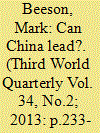

|
|
|
|
|
| Publication |
2013.
|
| Summary/Abstract |
The 'rise of China' is proving to be one of the most consequential developments of the early 21 century One of the key questions it raises is about the impact this historically unprecedented process will have on the East Asian region in particular and the world more generally. Will Chinese policy makers will be able to translate the country's growing material importance into other forms of political power and influence? Equally importantly, will Chinese elites be 'socialised' into the practices and norms of extant institutions, or will they attempt to redefine them to further Chinese foreign policy goals? This paper explores these questions by initially looking at the overall historical context in which East Asian regionalisation has occurred, before considering the operation of some of the more important regional institutions. It is suggested that China's ability to offer regional leadership is constrained both by its own security policies?which are seen as increasingly threatening by many of its neighbours?and by the actions of the USA, which is trying to reassert its own claims to regional leadership. While the outcome of this process is inconclusive, it helps us to understand the more general dynamics reshaping the international system as a result of the emergence of new centres of international power.
|
|
|
|
|
|
|
|
|
|
|
|
|
|
|
|
| 2 |
ID:
111030
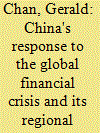

|
|
|
|
|
| Publication |
2012.
|
| Summary/Abstract |
This paper examines the role of China in the G20 and in East Asia in crafting appropriate responses and policies to the global financial crisis. Did China play an important part in the multilateralisation of the Chiang Mai Initiative, and how did China work with other players in East Asia to 'inoculate' East Asia against contagion and fallout from the crisis? The paper evaluates the type of leadership displayed by China and the decisions taken during the crisis. It assesses how the Chinese role in its own region and within global institutions such as the G20 would change in the aftermath of these crises.
|
|
|
|
|
|
|
|
|
|
|
|
|
|
|
|
| 3 |
ID:
171782
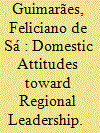

|
|
|
|
|
| Summary/Abstract |
In this paper, we analyze citizens’ attitudes toward regional leadership, employing two sets of survey experiments. Using Brazil as a case study, we analyze the first set of experiments with two types of regional leadership—structural and institutional—across three different regional issues—economic integration, regime change, and regional conflict. We found that Brazilians do not support either type of leadership, whether in regional conflict or in regime change issues, but support institutional leadership in economic integration scenarios. In the second set, we included specific South American countries both in regional conflict and in regime change scenarios. We found that Brazilians prefer Brazil to stay away from acting as a leader once neighboring countries are named in the experiment. Our findings indicate that the literature on regional leadership should incorporate the level of domestic support to understand its implications to the exercise of regional leadership. We embedded our experiments within the project “The Americas and the World: Public Opinion and International Politics, 2014–2015.” We used a nationally representative sample of eighteen hundred respondents undertaken in 2014.
|
|
|
|
|
|
|
|
|
|
|
|
|
|
|
|
| 4 |
ID:
145571
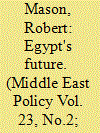

|
|
|
| 5 |
ID:
180345


|
|
|
|
|
| Summary/Abstract |
What explains the variation in how states collectively deal with public health challenges across different regions? We tackle this puzzle by comparing the regional health governance efforts pursued within the Central American Integration System (SICA) and the Union of South American Nations (UNASUR). We show that Central America's health governance has been driven by external actors, whereas South America's was driven by states within the region, and remained insulated from external actors’ influence. We argue that the explanation for such variation lies in the interplay of state capacity and regional leadership. In Central America, weak state capacity combined with the absence of a regional leader willing to provide governance resources. This opened up space for external actors to contribute actively to regional health governance, complementing the governance of Central American governments. In South America, Brazil's regional leadership mobilised neighbouring states’ capacities by promoting a South-South cooperation agenda based on intra-regional exchanges among national health bureaucracies, which, however, proved vulnerable to intergovernmental conflicts. Through the comparison of Central and South America, the article bridges the gap between global health governance scholarship and comparative regionalism, providing new insights on the determinants and effects of regional health governance modes in the Global South.
|
|
|
|
|
|
|
|
|
|
|
|
|
|
|
|
| 6 |
ID:
127052
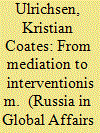

|
|
|
|
|
| Publication |
2013.
|
| Summary/Abstract |
During the first two years of the Arab Spring, Qatar's regional posture went into "overdrive," initially in Libya and subsequently in Syria. The country took advantage of the unique niche which it had spent years crafting in order to play an astoundingly high-profile and increasingly controversial role in the uprisings. Initially, it displayed unprecedented regional leadership bordering on outright activism in responding to crises across the Arab world. This greater self-confidence reflected multiple factors, including (relative) domestic stability and a progressive form of governance, as well as the ability to take and execute decisions quickly and the aforementioned experience in mediation. As a result, at the onset of the Arab Spring protests across the Middle East and North Africa, Qatar boasted a distinctive combination of characteristics rare in the Arab world, including regionally and internationally recognized legitimacy, a relatively progressive stance towards governance, an ability to make swift policy decisions, and extensive experience in mediation. All of these factors positioned Qatar to assume an extraordinarily visible and interventionist role during the Arab Spring upheaval.
|
|
|
|
|
|
|
|
|
|
|
|
|
|
|
|
| 7 |
ID:
132258
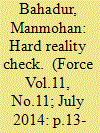

|
|
|
|
|
| Publication |
2014.
|
| Summary/Abstract |
Uttarakhand is one of the youngest states of India, formed just 14 years ago on 9 November 2000. It is also home to some of the most sacred shrines - Yamnotri, Gangotri, Badrinath and Kedarnath. One of these four sacred dhams of the Hindus, Kedarnath, was in the news for the devastating floods that struck it and the adjoining hills last year on June 16. It took some time for the extent of the calamity to hit home. The first person on the scene was an ex-Indian Air Force (IAF) pilot, Sqn Ldr Bhupinder VrC (fondly called Bhupi in the IAF) who was flying a civil charter helicopter in the area. Bhupinder was asked by the civil administration to fly to Kedarnath and Rambara to check what was wrong as all contact had been lost with the civil administration. In the words of Bhupinder,
"…I got a shock of my life as Rambara, a huge place, did not exist at all." This set in motion a flurry of activity, resulting in the mounting of perhaps the greatest heli-lift and rotary wing relief operation in the history of aviation.
|
|
|
|
|
|
|
|
|
|
|
|
|
|
|
|
| 8 |
ID:
072662
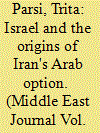

|
|
|
|
|
| Publication |
2006.
|
| Summary/Abstract |
This article argues that Iran's "Arab option" - the Arab and pro-Palestinian tilt in Iran's foreign policy - did not emerge out of the ideological musings of Iran's Islamic revolutionaries, but out of Iran's new-found position of preeminence in the later years of the Shah's rule. The sustainability of Iran's regional leadership required Arab acceptance and support, which could only be won through a pro-Arab orientation in Iran's foreign policy.
|
|
|
|
|
|
|
|
|
|
|
|
|
|
|
|
| 9 |
ID:
155309
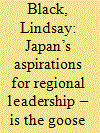

|
|
|
|
|
| Summary/Abstract |
Japan’s rise has often been conceived in terms of the ‘flying geese’ model in which Japan led a flock of emerging East Asian economies as its production networks expanded and it shed outdated technologies to the followers. Though the model implied a continuing Japanese leadership role in the East Asian region, two lost decades have undermined Japan’s claim to head the flock of ‘flying geese’ and Japan is often perceived as in decline relative to China’s rapid rise. This paper challenges such accounts to argue that Japan still has significant leadership ambitions and, potentially, the means to bring them to fruition. Understanding Japan’s leadership ambitions requires conceptualizing power in terms of discursive as well as material resources. Doing so highlights how different policymakers articulate contrasting visions of how Japan should take the lead in East Asia. These visions are of Japan as (variously) a functional leader, a conveyer of universal values, a conformist to ASEAN norms, a strategic partner and a promoter of open regionalism. Whilst most analyses have focused on Japan as a declining power, it is the spatial, temporal and ethical incompatibility of these regional visions that undermines Japan’s aspirations to lead the East Asian region.
|
|
|
|
|
|
|
|
|
|
|
|
|
|
|
|
| 10 |
ID:
132399
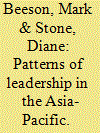

|
|
|
|
|
| Publication |
2014.
|
| Summary/Abstract |
Leadership at the regional level has come under the spotlight not only in the post-Cold War context, but also more recently following the global financial crisis. Yet, leadership by states within region-building and regional associations as leaders vis-à-vis other regions or powers remains relatively new territory for analysis and consideration, even though the Association of Southeast Asian Nations (ASEAN) has attracted both admirers and sceptics. This introductory essay is intended to achieve two principal objectives regarding this symposium addressing Asia-Pacific regional leadership. First, we seek to put the 'Asia-Pacific' in historical context and identify some of the forces that have not only shaped but also hindered its realization. Recognizing China's historical role and contemporary rise is important to understand the parameters within which ASEAN and its member states seek to define particular visions of regional identity and enact collective enterprises. The other key background consideration when thinking about contemporary leadership in the Asia-Pacific is that the United States is seemingly in decline. The Asia-Pacific's two most consequential powers - the United States and China - are pervasive considerations for any regional organization that aims to lead and promote cooperation to solve collective action problems.
|
|
|
|
|
|
|
|
|
|
|
|
|
|
|
|
| 11 |
ID:
111031
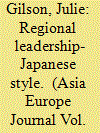

|
|
|
|
|
| Publication |
2012.
|
| Summary/Abstract |
The Japanese government faces many competing challenges as it seeks to balance its multilateral and bilateral relationships within and beyond the region: whilst addressing its rapidly changing contentious domestic politics, there is pressure for it to realign relations with the USA, manage the rise of China, strengthen links with its region and continue to deal with its lingering historical legacy. All of these demands are now set against the backdrop of a so-called 'lost decade' of economic woes and global economic recession. This article demonstrates how the Japanese government is apparently adopting a de facto multilevel foreign policy, attempting to engage in a range of bilateral and collective initiatives simultaneously and to assume a regional leadership role whilst having to manage difficult bilateral relations, notably with the USA and China.
|
|
|
|
|
|
|
|
|
|
|
|
|
|
|
|
| 12 |
ID:
164661


|
|
|
|
|
| Summary/Abstract |
In this article we show that small powers are able to socialize regional leaders using altercasting strategies. The altercasting operates within the leader's role repertoire replacing the master role—natural leader—with a previously inactive role—regional paymaster. This process is only possible because altercasting empowers domestic oppositions and recalcitrant secondary powers against the leader's initial master role, which is perceived as inadequate or unfair, unbalancing the leader's decision-making process towards an entire master role remaking. Since the regional community is a projection of the regional leader's values and interests, altercasting represents an effective bottom-up strategy available for small powers to socialize regional leaders and change their local community. We propose a theory refinement on master role transitions based on a mechanism that incorporates altercasting, domestic, and regional contestation concepts. We develop our argument using a case study—the 2006 Bolivian gas crisis.
|
|
|
|
|
|
|
|
|
|
|
|
|
|
|
|
| 13 |
ID:
113333


|
|
|
|
|
| Publication |
2012.
|
| Summary/Abstract |
This paper presents "strategic hedging" as a way to conceptualize much of the strategic behavior currently employed by second-tier states like China, Russia, Brazil, and France. Hedging is an alternative to strategies like balancing, bandwagoning, and buck-passing. Like those other strategies, hedging is driven by structural incentives associated with the current polarity of the international system and power concentration trends within it. Hedging will be most prevalent in international systems that are defined by a leading state that, while in a position of power preponderance, is also in the process of relative decline. Strategic hedging behavior is effective for second-tier states in such deconcentrating unipolar systems because it avoids outright confrontation with the system leader in the short term, while still increasing the hedging state's ability to survive such a direct military confrontation should it occur in the long run. Strategic hedging behavior can also be used to insure the hedging state against security threats that might result from the loss of public goods or subsidies that are currently being provided by the system leader. In this article, I define strategic hedging behavior, present a mechanism for identifying empirical evidence of strategic hedging, and apply that mechanism to three case studies: the Sino-Russian strategic partnership, Brazil's approach to regional leadership, and French opposition to the 2003 us invasion of Iraq.
|
|
|
|
|
|
|
|
|
|
|
|
|
|
|
|
|
|
|
|
|